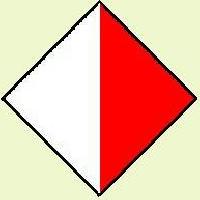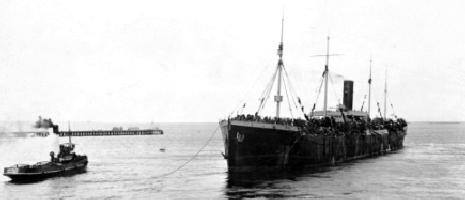Topic: AIF - Fr - 13 LHR
13th LHR, AIF
13th Australian Light Horse Regiment
Outline
Formation
The 13th Light Horse Regiment was formed as part of the 4th Australian Light Horse Brigade, 1915, 4th Contingent and attached to the Australian Division. Recruits went to the Broadmeadows Training Camp to the north of Melbourne, Victoria, from 1 March 1915. The recruits were drawn from throughout Victoria. Many of the men went from the Light Horse Militia formation into the AIF Light Horse.
Training

1. Light Horse On Parade; 2. Light Horsemen at Drill; 3. Marching Past the Governor-General; 4. Infantry in the making; and, 5. Army Service Stores.
[From: The Australasian, 17 April 1915, Picture Supplement, p. viii.]
Training for the 13th Light Horse Regiment commenced at Broadmeadows Training Camp to the north of Melbourne, Victoria, from 1 March 1915.
Embarkation
Embarkation of the 13th Light Horse Regiment was accomplished in two groups using both the HMAT A34 Persic and HMAT A44 Vestalia from Melbourne, Victoria.
The 13th Light Horse Regiment embarked on the HMAT A34 Persic from Melbourne, Victoria, 28 May 1915.
An assortment of men from the 13th Light Horse Regiment took part in a second embarkation on the HMAT A44 Vestalia from Melbourne, Victoria, 26 June 1915.
The 13th Light Horse Regiment sailed to Egypt and disembarked on 29 June 1915.
Colour Patch
Initially, the only colour separation of the various Australian mounted troops was by use of the pennant. The marker pennants were carried on poles to mark lines troop lines in camps in Egypt. They were not lance pennants as the Australian lancers had red over white pennants on their lances.

While this pennant was useful in distinguishing horse and troop lines, it failed to identify the individual with a unit. The AIF 1st Australian Division Standing Orders issued in December 1914 ordered the Australian Light Horse Regiments to wear a 4 inch wide [10.2cm] blue armband with the regiment name marked on the band in black lettering.
The earlier systems proved to be ineffective so to assist with identification of the men in the various units within the AIF, Divisional Order No 81 (A) Administration was issued at Mena on 8 March 1915 detailing the Colour Patches for the various units in the AIF. The colour patch was made of cloth 1¼ inches wide and 2¾ inches long and worn on the sleeve one inch below the shoulder seam. In contrast, a special amendment to the order created the 13th Light Horse Regiment patch which was a diamond granted under the original order.

When the 13th Light Horse Regiment was appointed as the 1st Corps Cavalry, the Regiment retained the colour patch originally issued. The colour patch carried the red Divisional colour as the left triangle part of the colour patch, while the white unit colour was on the right. This is illustrated with the above presentation.
Gallipoli
As mounted troops, the Light Horse was considered to be unsuitable for work in Gallipoli. The mounted troops volunteered to operate as infantry. On 11 September 1915 the 13th Light Horse Regiment was deployed on primarily defensive activities around the Lone Pine trenches throughout the stay at Gallipoli. The 13th Light Horse Regiment left the peninsula on 20 December 1915.
Defence of Egypt
After the return to Egypt, the 13th Light Horse Regiment moved to the Suez Canal taking part in its defence. The work was hot and monotonous. On 10 March 1916 the 13th Light Horse Regiment was broken up with a squadron allotted per division.
"A" Squadron was allotted to the 2nd Infantry Division.
"B" Squadron was allotted to the 4th Infantry Division.
"C" Squadron was allotted to the 5th Infantry Division.
The 13th Light Horse Regiment Headquarters and Machinegun Section were dispersed. This situation remained in force until May 1916 when the 13th Light Horse Regiment was reformed at Tel El Kebir, Egypt. The Regiment embarked with the 5th Infantry Division to France where the Regiment reassembled on 2 July1916. From then the 13th Light Horse Regiment was allotted to I Anzac Corps as Corps Cavalry.
France
Due to the static nature of the Western Front due to the trenches, traditional cavalry work was not available until the final stages of the war when mobility was a factor. Consequently, while the men from the 13th Light Horse Regiment participated in many of the major battles on the Western Front, it was done mainly as support troops. In that role the 13th Light Horse Regiment undertook traffic control, escort work and generally guarding the llines of communication.
After November 1917, 13th Light Horse Regiment became the Australian Corps cavalry regiment. When the Germans withdrew to the Hindenburg Line in 1917, the 13th Light Horse Regiment was able to take on the traditional reconnaissance role.
During the German St Michael Offensive in March 1918, the 13th Light Horse Regiment played its role in stemming the tide of the German advance. Once the German offensive had run its course, the 13th Light Horse Regiment was able to play an active role in the Allied counter attack and advance which lasted till the end of the war. Through traditional cavalry work, the 13th Light Horse Regiment was able to contribute much. One of its more outstanding operations occurring between 5 and 9 September 1918, was to provide work as advanced guard on a front of some 13.5 kilometres.
Return to Australia
After the cessation of hostilities, progressively the 13th Light Horse Regiment embarked for the long voyage to Australia where the unit was disbanded in Melbourne on 30 April 1919.
Commanding Officers
Lieutenant Colonel George Henry Dean
Lieutenant Colonel John McLean Arnott
Lieutenant Colonel Ernest Morgan Williams
Lieutenant Colonel Dudley Persee White
Lieutenant Colonel Alexander Mitchell
Lieutenant Colonel Stanley George Hindhaugh
Decorations earned by the 13th Light Horse Regiment
- 2 DSO - Distinguished Service Orders
- 5 MC & 1 Bar - Military Crosses
- 3 DCM - Distinguished Conduct Medals
- 30 MM - Military Medals
- 4 MSM - Military Service Medals
- 10 MID - Mentioned in Despatches
- 5 foreign awards
Campaigns
Gallipoli
- Sari Bair
- Gallipoli 1915-1916
Egypt
- Defence of Egypt
France
- Somme 1916
- Somme 1918
- Pozieres
- Bapaume 1917
- Arras 1917
- Ypres 1917
- Albert 1918
- France and Flanders 1916-1918
Casualties suffered by the 13th Light Horse Regiment
- 57 killed
- 328 wounded
War Diary
The Australian War Memorial has put these on line and may be accessed here:
Embarkations:
The following list details all the embarkations in support of the 13th Light Horse Regiment, AIF, during the Great War. Each entry details to formation and the ships on which the units embarked with the date and place of embarkation. The detail of the formation is linked to a list of men who embarked upon that ship on the specific date.
| Regimental Headquarters and Machine Gun Section | Melbourne, Victoria on board HMAT A34 Persic 28 May 1915 |
| Melbourne, Victoria on board HMAT A34 Persic 28 May 1915 Melbourne, Vic on board HMAT A44 Vestalia 26 June 1915 | |
| "B" Squadron | Melbourne, Victoria on board HMAT A34 Persic 28 May 1915 |
| "C" Squadron | Melbourne, Victoria on board HMAT A34 Persic 28 May 1915 |
| 1st Reinforcements | Sydney, New South Wales on board HMAT A40 Ceramic 25 June 1915 |
| 2nd Reinforcements | Melbourne, Victoria on board HMAT A57 Malakuta 10 September 1915 |
| 3rd Reinforcements | Melbourne, Victoria on board HMAT A55 Kyarra 20 August 1915 |
| 4th Reinforcements | Melbourne, Victoria on board HMAT A20 Hororata 27 September 1915 |
| 5th Reinforcement | Melbourne, Victoria on board HMAT A70 Ballarat 9 September 1915 |
| Melbourne, Victoria on board SS Hawkes Bay 26 October 1915 Melbourne, Victoria on board HMAT A38 Ulysses 27 October 1915 | |
| 7th Reinforcements | Melbourne, Victoria on board HMAT A40 Ceramic 23 November 1915 |
| 8th Reinforcements | Melbourne, Victoria on board HMAT A6 Clan Maccorquodale 6 May 1916 |
| 9th Reinforcements | Melbourne, Victoria on board HMAT A33 Ayrshire 3 July 1916 |
| 10th Reinforcements | Melbourne, Victoria on board HMAT A32 Themistocles 28 July 1916 |
| 11th Reinforcements | Melbourne, Victoria on board HMAT A4 Pera 23 September 1916 |
| 12th Reinforcements | Melbourne, Victoria on board HMAT A30 Borda 20 October 1916 |
| 13th Reinforcements | Melbourne, Victoria on board HMAT A38 Ulysses 25 October 1916 |
| 14th Reinforcements | Melbourne, Victoria on board HMAT A34 Persic 22 December 1916 |
| 15th Reinforcements | Melbourne, Victoria on board HMAT A67 Orsova 6 December 1916 |
| 16th Reinforcements | Melbourne, Victoria on board RMS Omrah 17 January 1917 |
| 17th Reinforcements | Melbourne, Victoria on board HMAT A11 Ascanius 11 May 1917 |
| 18th Reinforcements | Melbourne, Victoria on board HMAT A29 Suevic 21 June 1917 |
| 19th Reinforcements | Melbourne, Victoria on board HMAT A32 Themistocles 4 August 1917 |
| 20th Reinforcements | Melbourne, Victoria on board HMAT A32 Themistocles 4 August 1917 |
| 21st Reinforcements | Melbourne, Victoria on board HMAT A71 Nestor 21 November 1917 |
| 22nd Reinforcements | Melbourne, Victoria on board HMAT A38 Ulysses 22 December 1917 |
| 23rd Reinforcements | Sydney, New South Wales on board HMAT A18 Wiltshire 2 February 1918 |
See: Troop transport ships for information and photographs about the various ships employed in transporting the troops to Egypt.
Books:
Hunter, DJ, My Corps Cavalry - A History of the 13th Australian Light Horse Regiment 1915-1918, Melbourne 1999.
Further Reading:
13th Australian Light Horse Regiment, AIF
13th Australian Light Horse Regiment, Roll of Honour
Battles where Australians fought, 1899-1920
Citation: 13th Australian Light Horse Regiment, AIF, Outline






